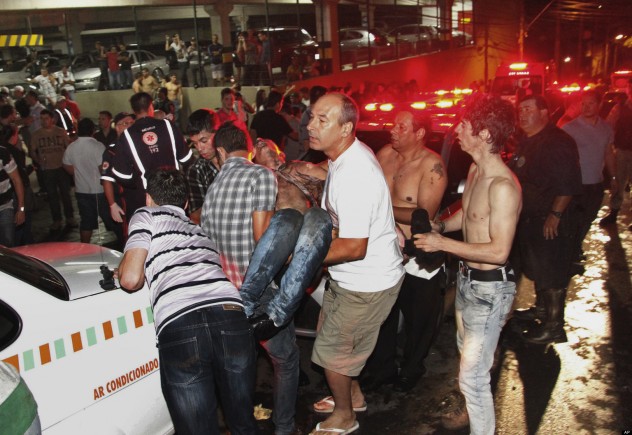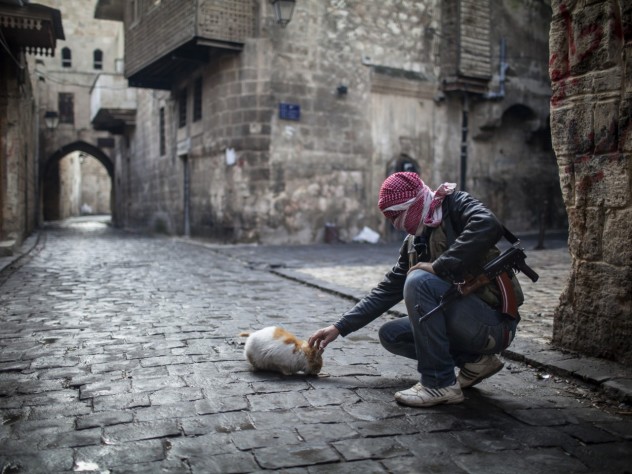 Music
Music  Music
Music  History
History 10 Less Than Jolly Events That Occurred on December 25
 Weird Stuff
Weird Stuff 10 Funny Ways That Researchers Overthink Christmas
 Politics
Politics 10 Political Scandals That Sent Crowds Into the Streets
 Weird Stuff
Weird Stuff Ten Bizarre Facts About The Doge Meme
 Our World
Our World 10 Ways Your Christmas Tree Is More Lit Than You Think
 Movies and TV
Movies and TV The 10 Coolest Stars to Set Sail on The Love Boat
 History
History 10 Things You Didn’t Know About the American National Anthem
 Technology
Technology Top 10 Everyday Tech Buzzwords That Hide a Darker Past
 Humans
Humans 10 Everyday Human Behaviors That Are Actually Survival Instincts
 Music
Music 10 Surprising Origin Stories of Your Favorite Holiday Songs
 History
History 10 Less Than Jolly Events That Occurred on December 25
 Weird Stuff
Weird Stuff 10 Funny Ways That Researchers Overthink Christmas
Who's Behind Listverse?

Jamie Frater
Head Editor
Jamie founded Listverse due to an insatiable desire to share fascinating, obscure, and bizarre facts. He has been a guest speaker on numerous national radio and television stations and is a five time published author.
More About Us Politics
Politics 10 Political Scandals That Sent Crowds Into the Streets
 Weird Stuff
Weird Stuff Ten Bizarre Facts About The Doge Meme
 Our World
Our World 10 Ways Your Christmas Tree Is More Lit Than You Think
 Movies and TV
Movies and TV The 10 Coolest Stars to Set Sail on The Love Boat
 History
History 10 Things You Didn’t Know About the American National Anthem
 Technology
Technology Top 10 Everyday Tech Buzzwords That Hide a Darker Past
 Humans
Humans 10 Everyday Human Behaviors That Are Actually Survival Instincts
Top 10 News Stories Of 2013 (So Far)
It can be difficult to keep up with the latest news stories when you work a full-time job, go to school, have children, or do all three. That’s why we’ve compiled the biggest stories of the year—not only are they fascinating, they’re likely to shape the rest of 2013.
10Fluoridated Water Controversy

Fluoride is a monovalent ion that is used in tooth-protection products. In 1945, the substance started being added to the water supply in many countries to prevent tooth decay. As of 2004, approximately 400 million people around the world have their water tapped with fluoride. The policy of water fluoridation is controversial and has created ethical, legal, and safety concerns among parents. It has been widely reported since the end of World War II that the substance doesn’t harm humans in low doses. However, the ingestion of sodium fluoride is not approved by the US Food and Drug Administration and the substance is labeled a rat poison.
Over the years, a large amount of studies have been carried out that show fluoride is harmful to people who drink it. The first such experiment was reported in the 1956 Journal of the American Dental Association in which the population of Newburgh, New York was studied. In the experiment, the people exposed to sodium fluoride-laced drinking water had more bone defects, anemia, and evidence for earlier female menstruation. In 2013, it was reported that Harvard University published a paper that showed populations that drink fluoridated water have children with substantially lower IQs.
In the study, researchers examined the data from a collection of experiments that focused on fluoride and brain activity. The results showed that kids who drank water with fluoride had experienced adverse effects to their neurodevelopment and had lower IQs. It was also explained that fluoride exposure has a negative impact on fetus development, and if you mix baby formula with fluoridated water it contains 100 to 200 times more fluoride than breast milk.
The children in the study were selected from countries that have a higher percentage of fluoridation in their water than the United States, but the varying levels of regulation on water fluoridation in these different countries should also be taken into consideration. More research into the subject should be carried out. We should be testing the brain activity of those in areas exposed to fluoride and those who are not. The mass exposure of fluoride has also caused a prevalent disorder in humans called dental and skeletal fluorosis, which is characterized by white and brown stains on the teeth and damaged bones.
9 United States Ammunition Shortage

Since April 2013, it has been reported that certain calibers of bullets can’t be found in U.S. stores, including the .380 Auto, .45ACP, and .40 S&W pistols. The shortage includes a wide range of cartridges used for popular semiautomatic rifles and pistols, which has caused some to speculate that the US government is preventing the sale of bullets in order to enforce a subtle form of gun control.
The shortage has reached sports stores across the United States and resulted in higher prices for ammunition and months-long waiting lists to purchase bullets. Meanwhile, the US Department of Homeland Security has put forth an order to buy 1.6 billion rounds of ammunition. These rounds would allow the Department of Homeland Security to fight a 24-year Iraq War—which seems a bit excessive, and has aroused the suspicions of many Americans.
8 Murder of Odin Lloyd

Odin Lloyd was a 27-year-old semi-professional football player found murdered on June 17, 2013 by a jogger in North Attleborough, Massachusetts. In the aftermath of the crime, police became suspicious of professional football player Aaron Hernandez, who had been seen with Lloyd before his death. Lloyd had been dating the sister of Hernandez’s fiancée, and his body was found less than a mile from Hernandez’s home.
On June 18, 2013, police searched Hernandez’s residence and discovered that his security system had been intentionally destroyed after the murder. It was also discovered that Hernandez had crushed his cell phone and hired a team of cleaners. It was reported by the Boston Globe that Lloyd was shot five times in the chest and back area in an execution-style crime.
A media circus quickly ensued, and as people began to look into Hernandez’s history they found a troubled past. On June 13, 2013, a man named Alexander S. Bradley sued Hernandez for allegedly shooting him following an altercation at a Miami club. Bradley claimed that he was shot at by Hernandez and the bullet ricochet to his face, which caused him to lose his right eye. Hernandez was also questioned in a shooting that occurred when he played football at Florida University.
On June 26, 2013, Aaron Hernandez was arrested at his North Attleborough home and charged with the murder of Odin Lloyd. Two hours after his arrest, he was released from his team, the New England Patriots. He is currently on trial for murder with no chance of bail.
7 Horse Meat Scandal

In 2013, a meat scandal was exposed across Europe. It was initially reported in January of 2013 that some meat being labeled as beef in Irish and English food markets was actually horse and pig. The news caused an outrage in Europe.
The scandal has exposed a major problem in the tracking of food shipments across the world. Horse meat has been found in a large number of European communities, which has made it difficult to determine exactly where it is coming from. Some distributors who have been accused are Silvercrest, Dalepak, Freshlink, and ABP Nenagh, with stores including Tesco, Asda, Dunnes Stores, Lidl, and Aldi. In England and Ireland, Burger King was found to be selling hamburgers made of horse meat. In the wake of the scandal, the sales of frozen hamburgers and ready meals have dropped considerably in Europe.
The scandal has shocked many Muslim and Jewish communities who have been tricked into eating foods outlawed by their religions. In one case, school children were given halal chicken sausages with traces of pig meat.
The news has caused a collection of governments to examine their food supply in hopes of preventing a similar scandal, with disturbing results: In South Africa, beef dishes have been found to contain water buffalo, goat, and donkey meat.
6 Kiss Nightclub Fire

On January 27, 2013, the Kiss Nightclub in Rio Grande do Sul, Brazil suffered one of the third-deadliest fires in Brazilian history. Students from six different universities had met at the nightclub in order to celebrate an end of the summer party, hiring two separate bands to perform at the club. As the group Gurizada Fandangueira was on stage, the band ignited an outdoor pyrotechnic device similar to a signaling flare, which quickly caught the acoustic foam in the ceiling on fire, and spread across the building. As panic spread, a massive crowd formed at the base of the front door, which was the only exit in the nightclub.
This is where things get bizarre: There are reports that the nightclub’s guards thought that the commotion was caused not by a fire, but by a large fight—so they prevented people from fleeing the nightclub in order to get them to pay their bills.
After the fire was extinguished, the scene inside the nightclub was described as a war zone. At least 242 people were found dead. Ninety percent of the victims died of smoke inhalation and many were found in the bathrooms. Sadly, most of the victims were young people between the age of 18 and 30.
On April 2, 2013, two nightclub owners and two band members were charged with manslaughter.
5 Resignation Of Pope Benedict XVI

On February 11, 2013, Pope Benedict XVI announced that he would resign—the first time a pope had done so since Gregory XII in 1415. He cited his “advanced age,” along with the physical and mental demands of the papacy, as the reason for his resignation.
Naturally, a large number of conspiracy theories have emerged in the wake of this controversial move. On February 22, 2013, some organizations alleged that Pope Benedict was given a 300-page dossier by a group of cardinals the day before he resigned that reveal a massive conspiracy involving factions of gay men within the church engaging in lewd sexual conduct with prostitutes.
On March 13, 2013, it was announced that Jorge Mario Bergoglio would become the 266th Pope of the Catholic Church. After the decision, Bergoglio picked the papal name of Francis in honor of Saint Francis of Assisi. The decision was surprising as Francis became the first Jesuit Pope and the first pope from the Americas. He has quickly gained a reputation for kindness and humility and has chosen to live in a Vatican guesthouse rather than the papal residence.
4 Savar Building Collapse

On April 24, 2013, an eight-story commercial building named Rana Plaza collapsed in Savar, Bangladesh. The disaster is considered the deadliest accidental structural failure in modern history, with a death toll of 1,127. At the time of the collapse, Rana Plaza contained clothing factories, apartments, and a variety of shops. The lower floors of the building were evacuated the day before the disaster due to cracks in the structure, but a large percentage of workers were forced to attend work that day despite the danger.
It was later revealed that the top floors of Rana Plaza were constructed without a permit. The building housed a large collection of machines for factory work, which wasn’t permitted under the structural details. The constant weight and vibration of the heavy machinery caused the building to lose stability. After the structure collapsed, only the bottom floor was left intact. A search effort was carried out for several weeks with hundreds of victims being pulled out of the rubble alive. On May 10, 2013, 17 days after the collapse, the last survivor was found.
3 The Floods

The world has been devastated by a large collection of floods in 2013. Starting on June 14, 2013, North India started to receive massive amounts of rainfall which led to what may be the worst monsoon season in India in over 50 years.
On June 23, 2013, the death toll from the North Indian floods reached over 6,500, with many people still missing. It has been estimated that around 100,000 people have been evacuated from North India in the wake of the floods.
Starting in June of 2013, a high-pressure system has caused heavy rain to hit Calgary and surrounding areas, causing the worst flood in its history. Over 100,000 people have been displaced from their homes, and the estimated cost of the damage is between C$3–5 billion.
Central Europe has also seen a large amount of water damage this year with parts of Germany, the Czech Republic, Austria, Switzerland, Slovakia, Belarus, Poland, Hungary, and Serbia being struck by major floods. In May and June of 2013, areas of Austria and Germany experienced a huge surge in rainfall that hasn’t been recorded in years. The Czech Republic has been forced to declare a state of emergency in seven regions of the country, including Prague.
On the other side of the planet, in January 2013, a series of monsoons passed over Eastern Australia and caused widespread damage in excess of A$2.4 billion (US$2.5 billion). The area of Jakarta received extensive rainfall in January 2013, causing several destructive floods.
In early April, 2013, the city of La Plata, Argentina experienced its worst flooding in history. The floods swept over the northeast section of Buenos Aires Province and caused 80 deaths.
2 PRISM

In June of 2013, a former CIA contractor named Edward Snowden exposed a massive surveillance program named PRISM operated by the United States, Great Britain, Canada, New Zealand, and Australia. PRISM includes the storage of information collected from Internet history, telephone calls, and texts. With the help of The Guardian (London), Snowden has published a collection of articles indicating that major telecom companies have been sharing metadata for calls made between private U.S. citizens with the government.
The companies involved are protected under the Protect America Act of 2007 and FISA Amendments Act of 2008, which legally immunizes private companies that help the U.S. government gather intelligence. Among the companies named with PRISM include Google, Facebook, Yahoo, Microsoft, YouTube, AOL, Skype, and Apple.
After the existence of PRISM was made public, the U.S. Director of National Intelligence released a statement saying that the U.S. government has not been gathering intelligence on U.S. citizens—a claim blatantly contradicted by Snowden’s leaks.
The reaction to the program has been extensive, with many governments calling PRISM an infringement on human rights. Officials in China, Italy, and Germany have condemned the data mining. The American Civil Liberties Union filed a lawsuit against the NSA saying that the program “violates Americans’ constitutional rights of free speech, association, and privacy.” Freedom Watch has also filed a lawsuit against the companies believed to be involved with the controversial sharing.
1 Syrian Civil War

The current war in Syria began on March 15, 2011 and has caused the death of approximately 100,000 people—about half of whom are citizens.
The people of Syria have called for the resignation of President Bashar al-Assad, whose family has held the presidency in Syria since 1971. They have created the National Coalition for Syrian Revolutionary and Opposition Forces. The coalition was recognized as the legitimate government of Syria by the Arab League in 2013 and has been supported by the European Union and the United States, who have enforced a large amount of sanctions against Syria since the war started.
In January of 2013, the UN released a report that detailed crimes against humanity committed by the Syrian government, including the use of chemical weapons against the rebels.
In 2013, the Syrian government released a statement indicating that all Western reporters would be targeted in the war. In February, award-winning American journalist Marie Colvin was killed at the siege of Homs in Syria. By March of 2013 it was estimated that around 150 journalists had been killed in the Syrian Civil War. In May of 2013, U.S. and Russian officials jointly called for an international peace conference to discuss a plan for ending the war. In June of 2013, the UN submitted the largest aid appeal in history to help Syria, reported at $5 billion.








